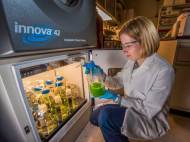Modifying cyanobacteria for better biofuel production
 Micro-algal fuels might be one way to reduce our dependency on fossil fuels, and they could reduce carbon dioxide emissions since they use photosynthesis. Sandia National Laboratories researcher has engineered two strains of cyanobacteria to produce free fatty acids, a precursor to liquid fuels, but she has also found that the process cuts the bacteria’s production potential.
Micro-algal fuels might be one way to reduce our dependency on fossil fuels, and they could reduce carbon dioxide emissions since they use photosynthesis. Sandia National Laboratories researcher has engineered two strains of cyanobacteria to produce free fatty acids, a precursor to liquid fuels, but she has also found that the process cuts the bacteria’s production potential.
Anne Ruffing, Truman Fellow at Sandia’s Bioenergy and Defense Technologies Department, studied the direct conversion of carbon dioxide into biofuels by photosynthetic organisms such as algae. Instead focusing on eukaryotic algae, the natural “oil”-producing photosynthetic microorganisms, she used performed her research on cyanobacteria (blue-green algae) since they are easier to genetically manipulate, and because cyanobacteria can be engineered to create a variety of target fuels.
Genetically engineered cyanobacteria excrete free fatty acid (FFA) and allow fuel to be collected without harvesting the cyanobacteria, since fuel from engineered cyanobacteria is excreted outside the cell, in contrast to eukaryotic algae which produce fuel inside the cell. That eliminates the need to grow a new batch of algae each time, saving on nitrogen and phosphate.
But current yields from engineered strains are too low for large-scale production. While other research efforts have focused on metabolic engineering strategies to boost production, Ruffing wants to identify what physiological effects limit cell growth and FFA synthesis.
“You can’t really hope to continue to engineer it to produce more of the fatty acids until you address these unforeseen effects”, said Ruffing. “As much as you want to do the applied side of things, creating the strain, you can’t get away from the fundamental biology that’s necessary in order to do that.”
The strains she engineered for FFA production show reduced photosynthetic yields, degradation of chlorophyll-a and changes in light-harvesting pigments. Ruffing saw some cell death and lower growth rates overall, and suspects that the toxicity of unsaturated FFA and changes in membrane composition are responsible.
She chose Synechococcus elongatus PCC 7942 and Synechococcus sp. PCC 7002 as so-called model organisms since they have been studied for several decades and have established tools for gene manipulation. Aside model organisms, she’s performing biofuel toxicity screening on Synechocystis sp. PCC 6803. Ruffing is creating mutants by knocking out certain genes or introducing or overexpressing genes to see how that affects the cell and fatty acid production.
“It is possible that there’s a natural strain out there that could be a better option, so this is still pretty early research”, said Rufifng. “So I’m engineering the cell, then I’m trying to learn from the cell how to work with the cell to produce the fuel instead of trying to force it to produce something it doesn’t want to produce.”
For more information, read the article published in the journal Biotechnology and Bioengineering: “Physiological effects of free fatty acid production in genetically engineered Synechococcus elongatus PCC 7942”.









Leave your response!